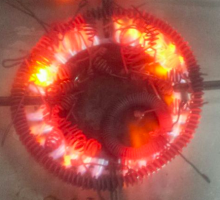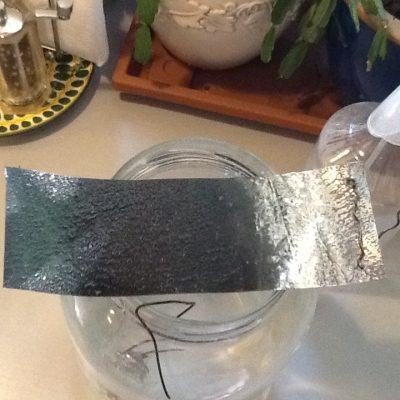Table of Contents
Nano coating, teflon style
 Nano coating your wires Teflon style:
Nano coating your wires Teflon style:
- .First dip your coils in a GaNS mix
- Put them on a stove. When they get red hot , spray some water on them from a distance
- Repeat this every 3 minutes until you are happy with your coating
- Drain with your volt meter.
Now you are a step closer to your free energy device. From Alekz.
Nano-Coating with LP
by KF Romania
They have replaced distilled water in the caustic solution nano-coating process for MaGrav coils by LP of all the 4 basic GaNSes in equal measures; they have also assembled and tied the coils to the stacker structure.
As a result the coils have had a more homogeneous and blacker nano-coating. The black color appeared already after 30 min after they have been taken out of the caustic liquid. The nano-layers seem more coherent and don’t rub off easily.
Nano-coating by other elements
NaOH is normally used, KOH has recently been added – and other salt-like elements such as epsom salt (Mg) can be added. This gives other qualities to the coating, other field forces.
Mr.Keshe KSW175 @ 0:13:00
If potassium (K) is added, a different nano caoting is obtained. The addition of K can be done by a salt that is sodium free. There is also radioactive material called K40. This makes the nanoplating particles have more energy, they will therefore be spaced more apart and conduct the plasma more efficiently.
Aluminium nano-coating
- Heat 3 cups distilled water and 1 cup cold caustic solution (in a Crockpot) at 55-57ºC (134-136ºF)
- Soak the piece of aluminium very briefly and remove it
- Let it dry in the air
If you want to nano-coat aluminium cans:
- remove prints with nail polish remover
- pass the piece under the torch making very short passages (do not stop otherwise the metal melts)
Zinc Nanoplating
Zinc is not really tackled with caustic soda; HCL should be taken better. Paint the zinc plate with hydrochloric acid on both sides; place in an airtight container and leave to plating for 12 hours in a warm place (radiator).
HCL must be applied outside, as very corrosive vapours develop!
Nano-coating transfer
(par Mark House)

I used sea salt with a Cu-np electrode; the Zn plate was placed in the glass pot I use for GaNS-CO2 production; I decided to add some caustic soda crystals.
The result is that the nanoplating transferred from the Copper to the Zn plate.
The other two masson jars contained single copper coils with nano plated copper coils; in this example plating was also transferred.
So one can draw the conclusion that the ionization of carbon atoms can be transferred from the wires that were nano plated before onto another plate, coil or wire in a salt water environment with a little caustic.
By CaO
par Plasma-Laurentides
CaO is calcium oxide called quicklime. It is a white powder that reacts with water by a great release of heat. The reaction with water produces calcium hydroxide (slaked lime). :
Cao+H2O which gives Ca(OH)2; Hydrated lime should be basic enough for nano coating copper. It’s worth a try… so I did it and the result is a black coil.
Plasma Nanocoating
By Donovan Guerra
Hello everyone! It is always a pleasure to share in this forum. There are some exciting news; especially David Mulnix’s contributions on the Keshe Manufacturing Arizona page. His reflections were really helpful for me to do nanocoating by the forces of the field, which is the 3rd way of nanoplating.
That’s how I did it:
The typical arrangement to produce GaNS CO2
Use Seignette salt (Rochelle salt, potassium sodium tartrate, C4H4KNaO6), in a 10% solution instead of ordinary salt (NaCl).
Placing anything near the Zn plate gets nanoplated in a few minutes; very thick after 24 hours. This arrangement does not use power.
A variation: place a Cu wire close to the Zn plate with a little point water 2) in a plastic bag (top picture). After one day there was a good layer of nanoplating. The same thing happens with a silver necklace – after one day it was black. I tried to make GaNS with the nanoplated pieces successfully.
Nanocoating – by plasma
By David Mulnix (USA-Plasma Times June 7, 2017)
The plating is done in a conventional GaNS-CO2 production facility; the object to be plated is installed close to the Zn plate.
The Cu’s gonna nano plating in a few minutes.
David successfully tested the Cu plated in a GaNS-CO2 production facility.